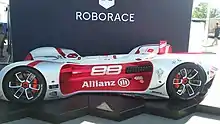Self-driving car
A driverless car (also called autonomous car or self-driving car, i.e. self-operating) is a vehicle that can perform certain tasks on its own, without the help of a human driver. The car uses sensors to analyze its environment, and doesn't need a human's help for certain tasks.[1] These tasks commoly include parking the car, driving while keeping the same lane on a highway or driving at a predefined speed. In public places, certain buses have been programmed to travel a given route. As of 2021, self-driving cars have been used in controlled envirnoments more and more. An example of this might be buses that transfer passengers between airport terminals.



Technology
Typical sensors used by a self-driving vehicle include lidar, digital cameras, GPS and IMU.[2][3]
High-definition maps can be used to accurately locate a self-driving car in a place, and to give information about parts of a road not seen by the car.[4]
Ethical issues
Even though it is technically possible to build cars that do certain things on their own, the question whether it should be done is different. Ethical questions include:
- Is a machine able to judge a situation correctly? – Can it make a difference between a stroller with a child, and a stroller with a doll?
- Is it acceptable to judge a situation by the expected death toll? (This has been formalized as the trolley problem.)
- If it is acceptable to judge such a situation by the expected death toll, what are meaningful criteria? – should the age of those killed be taken into account?
Legal issues
Even though these vehicles can already do a lot on their own, the laws of most countries still require that a driver is present. In many cases, self-driving buses also need a special permit from the government.
If a motor vehicle produces an accident, there always is the question of who is responsible, to determine what damages need to be paid. This also applies to self-driving cars: A self-driving car is like a robot: Software is used for the driving. This software relies on a number of sensors to take decisions. Determining what went wrong in the case of an accident can be very difficult. This includes the question of who is legally responsible.
References
- Gehrig, Stefan K.; Stein, Fridtjof J. (1999). Dead reckoning and cartography using stereo vision for an automated car. IEEE/RSJ International Conference on Intelligent Robots and Systems. Vol. 3. Kyongju. pp. 1507–1512. doi:10.1109/IROS.1999.811692. ISBN 0-7803-5184-3.
- Huval, Brody; Wang, Tao; Tandon, Sameep; Kiske, Jeff; Song, Will; Pazhayampallil, Joel (2015). "An Empirical Evaluation of Deep Learning on Highway Driving". arXiv:1504.01716 [cs.RO].
- Corke, Peter; Lobo, Jorge; Dias, Jorge (1 June 2007). "An Introduction to Inertial and Visual Sensing". The International Journal of Robotics Research. 26 (6): 519–535. CiteSeerX 10.1.1.93.5523. doi:10.1177/0278364907079279. S2CID 206499861.
- Liu, Rong; Wang, Jinling; Zhang, Bingqi (27 August 2019). "High Definition Map for Automated Driving: Overview and Analysis". Journal of Navigation. 73 (2): 324–341. doi:10.1017/S0373463319000638. ISSN 0373-4633. S2CID 202906063.